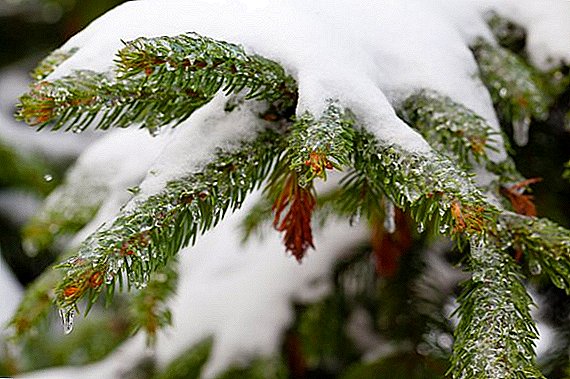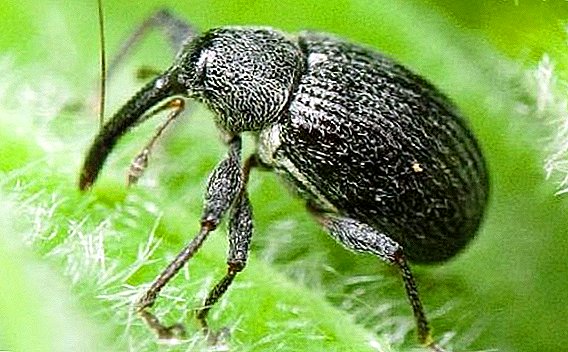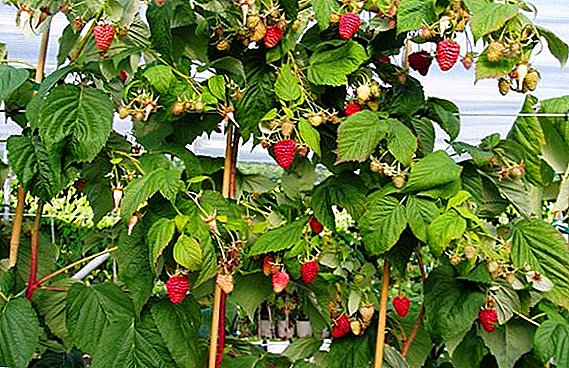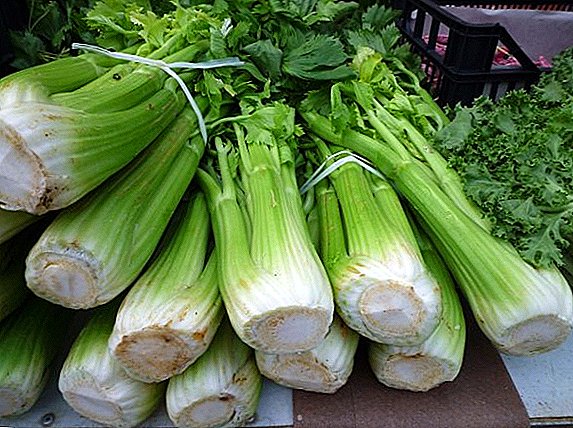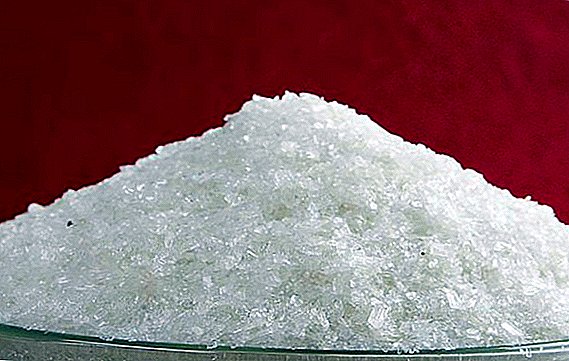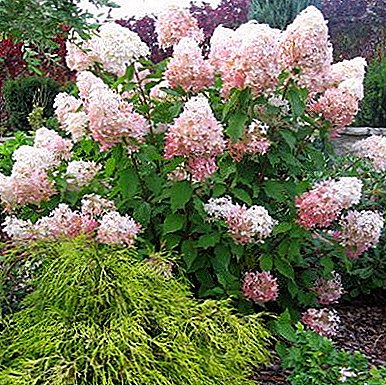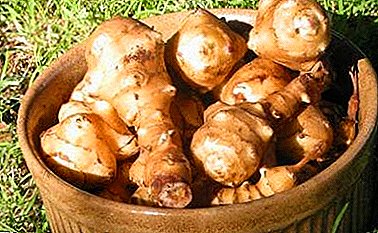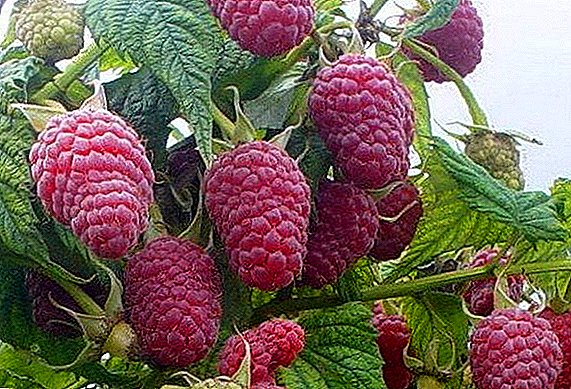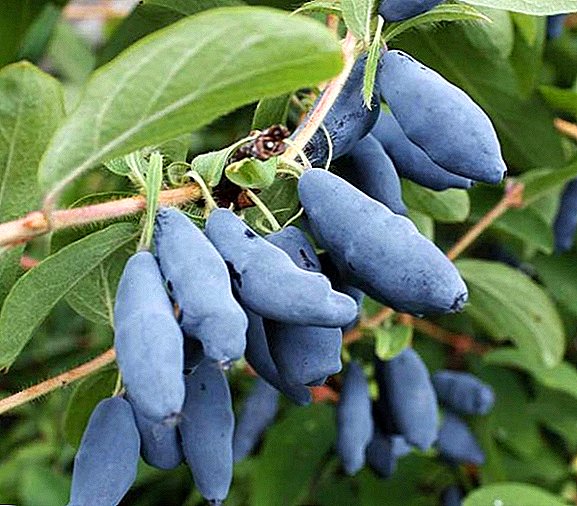 The unique variety of durable and unpretentious plant of honeysuckle "Nymph" will serve gardeners not only an excellent harvest of sweet and sour berries, but also a hedge to decorate the garden plot. This is a fairly productive and profitable plant species, giving a rich harvest for about 25-30 years, and also does not require special costs for its development.
The unique variety of durable and unpretentious plant of honeysuckle "Nymph" will serve gardeners not only an excellent harvest of sweet and sour berries, but also a hedge to decorate the garden plot. This is a fairly productive and profitable plant species, giving a rich harvest for about 25-30 years, and also does not require special costs for its development.
Breeding history
This species was first bred at the Pavlovsk Experimental Station of the All-Russian Research Institute of Plant Industry named after N. I. Vavilov in St. Petersburg. It comes from a free pollinator of a variety called the Leningrad Giant. The title of authors for the breeding of this species was given to famous scientists - M. N. Plekhanova and A. V. Kondrikova. 
Did you know? In 1998, the variety's honeysuckle "Nymph" officially entered into the State Register of Breeding Achievements, and in 2012 - into the State Register of Varieties for Household Cultivation.
Variety description
Honeysuckle "Nymph" - the brainchild of Pavlovsk breeding, deservedly bearing the title of one of the best varieties of durable berry bushes to date. If you refer to a brief description of the variety, you can imagine a green shrub with bluish-blue berries with unsurpassed taste. The resistance of the crop to low air temperatures is a distinctive feature of the plant, allowing it to survive not only cold winters, but also returning early spring frosts.
Bushes
The honeysuckle shrub of this species is upright and tall (reaches a height of 2 meters), has an oval sprawling crown with slightly pubescent shoots and large leaves of the same shape with sharpened ends. 
Important! Unique decorative honeysuckle "Nymph" plays an excellent role in landscape design in the form of hedges.The shoots are brownish-green, and the leaves are green in a dark shade. The main part of the sheet has a slightly wavy flat surface with a base in the form of a wide oval.
Berries
Excellent taste qualities of the berries of this honeysuckle variety are presented. combination of sour and sweet taste with a certain hint of astringency, giving refinement and extraordinary fruit. Large spindle-shaped or ellipsoidal blue berries with a slight amethyst shade, as well as a waxy bloom of dense density, will delight gardeners with their appearance at the end of June. 
Did you know? The well-known "wolfberry" is also a type of honeysuckle, but inedible, but on the contrary, has a toxic effect on the body. Distinguish safe berries from poisonous in their color: you can eat only the fruits of a cold dark shade (black and blue), and screaming bright colors (red, orange) as if they themselves warn about possible health risks.The advantage of honeysuckle "Nymph" is a reliable attachment of fruits to the branches, which allows them not to crumble for a long time and delay harvesting (in case of lack of time).

Specifications
Fruit ripening period: late (end of June).
Bush: medium (1.5-1.7 m) and tall (1.7-2 m) with a thick oval crown.
Shoots: long and straight, slightly pubescent.
Leaves: large, elongated oval shape with a wide-round base and pointed ends.
Berries:
- average weight - 1.6 g, maximum - 3 g;
- shape and size: ellipsoidal-elongated / spindle-shaped form (average length of a berry is 28-30 mm, diameter is approximately 10 mm);
- surface: bumpy;
- taste characteristics: a pronounced sweet-sour taste and rich pleasant aroma;
- pulp structure: fibrous.

Important! An exceptionally rich set of vitamins and minerals contained in honeysuckle, allows you to use it also for medicinal purposes. Berries have a beneficial effect on the cardiovascular and digestive systems, and thanks to their urinary and choleretic properties, they perfectly cleanse the body of toxins and other harmful substances.The maximum yield reaches 3 kg per bush. Skoroplodnost enough developed: The plant gives a harvest for the 3-4th year after planting and gives birth for 25-30 years. Features: high cold resistance.

Where to plant honeysuckle?
Due to its uncomplicated nature, the plant develops well after planting even in the spring-summer period, however, except for May and June (when there is an active growth of shoots). Still, gardeners recommend mid-fall (late September-October) as the best period to start development.
Did you know? Scientists say that the smell of honeysuckle helps to cope with stress, anxiety, insomnia.Since the plant loves the light, then you need to plant it on well lit and even better sunny areas of the garden, with loamy soil of neutral composition (mainly clay, sand).
How to care for a grade
The unique dessert variety of honeysuckle "Nymph" - kind of durable shrub with edible berries, not requiring special conditions for planting and its further development. Since the “Nymph” requires pollinating neighbors for its fruitfulness, such varieties of honeysuckle as “Amfora”, “Chosen One”, “Pavlovskaya”, and also “In Memory of Gidzyuk” will be the best options. Having provided a sunny part of the garden for the plant as a house, as well as abundant watering in the summer, you can see the positive results of your work in the very first years after planting.
Watering and soil care
Planted seedlings of this type of edible honeysuckle better before the onset of cold weather so that the plant has managed to take root and in the future normally endure the cold season. Landing sites should be well lit and protected from the wind, and the soil prepared in advance: dug up and neutralized with calcareous materials. If rotted, broken or dry roots are found on the seedling, they must be removed, and their average length for planting should not exceed 30 cm.
Important! The impeccable taste of the crop is directly dependent on the large amount of sun provided on the garden plot.
 Dimensions of landing holes in each individual case they depend on the size of the rhizomes themselves, but on average these characteristics are as follows: 0.4 x 0.4 m. A small mound is formed in the hole from the top fertile soil layer where the seedling is placed, gently straightening the roots on an inclined plane in different directions , and fall asleep with the rest of the ground above. The depth of the root of the plant should not exceed 3-5 cm from the surface of the site. Well-compacted soil around a young shrub should immediately be poured abundantly, and then mulched.
Dimensions of landing holes in each individual case they depend on the size of the rhizomes themselves, but on average these characteristics are as follows: 0.4 x 0.4 m. A small mound is formed in the hole from the top fertile soil layer where the seedling is placed, gently straightening the roots on an inclined plane in different directions , and fall asleep with the rest of the ground above. The depth of the root of the plant should not exceed 3-5 cm from the surface of the site. Well-compacted soil around a young shrub should immediately be poured abundantly, and then mulched.It should be noted that in the process of plant growth, special attention should be paid maintaining soil moisture levels in which the plant develops, as insufficient watering affects the taste and quantity of fruits.
In the not hot period with an average rainy level, the amount of crop irrigation should reach 3–4 times per season at a rate of 10–12 liters per bush. In late spring, when hot and dry weather is coming, watering should be increased. 
Top dressing
The first couple of years after planting, the plant does not need additional feeding, since the nutrients with which the composition of the upper fertile soil is saturated are quite enough for it. After that, the nymph honeysuckle begins to require additional care, for which organic substances are well suited: manure in rotted form, humus or compost. In the spring, before swelling of the kidneys, the plant is fed 15 g of ammonium nitrate per square meter of land or 30 g of urea under a shrub. These substances are diluted with water.
Pruning
Pruning a plant is done after the crown begins to thicken, the plant's lifetime is about 3–4 years after planting. It is necessary to begin pruning from zero stems (growing from the ground), then remove sick, dried, broken, short branches in turn. Pruning contributes to a better penetration of sunlight, making the plant better fruit. The processes of removal of excess branches are carried out mainly in the fall, and in the spring the sick parts of the plant are removed by the frost and the diseased parts (the so-called sanitary pruning after wintering). 
Pest and disease control
This type of honeysuckle is well resistant to diseases and pests, despite the fact that it affects them no more often than its similar long-lived shrubs. Among the insects that interfere with the normal development of honeysuckle "Nymph" include the following:
- legworm caterpillars (destroy the tops of young shoots and leaves during the period of ripening berries);
- fingerfly caterpillars (fed with seeds inside the berries);
- aphid (eats the juice contained in the leaves of the plant);
- willow shchitovka (sucking the juice from the honeysuckle bark).

Important! After watering or rain, it is recommended to loosen the soil around the shrubs. Since the rhizomes are very close to the surface, loosening and removing weeds, as well as parts of the roots, is done at a depth of no more than 5-8 cm.A good tool in the fight against these pests are insecticides, for example, "Inta-Vir", "Alexar", "Fitoverm", "Agravertin" and others. Powdery mildew is the only disease that can befall the plant. But, using the solution of the microbiological antibacterial drug "Fitosporin", you can completely forget about this problem.
To get a bountiful harvest of sweet berries, learn how to deal with pests of honeysuckle in the garden.
Wintering "Nymphs"
This variety of honeysuckle has high cold resistance that allows him to safely endure frosts, as well as develop in extreme conditions. In order to facilitate this process, it is possible to fertilize the soil with a mixture of compost, ash and superphosphate before the arrival of winter in the following proportions: 5 kg: 100 g: 40 g. The indicated amount is calculated per square meter of land. 
In addition to the nymph honeysuckle, frost-resistant plants are also: lilac, spirea, white turf, barberry, mountain ash (red), viburnum, and bird cherry.
The advantages and disadvantages of the variety
Among positive qualities inherent in this variety, the following can be called:
- high frost resistance;
- slow shedding;
- abundant yield;
- unusual taste of berries.
Important! Universal variety: honeysuckle berries "Nymph" You can include in your diet in either fresh or dried, frozen, canned or processed (jam, jelly, fillings for pies, compotes, juices, wine).
 After harvesting, it is necessary to be extremely careful when harvesting, as the skin on the berries is very thin, and damage to it can affect the taste. Moreover, fresh picked berries are not able to persist for more than a couple of days even at cold temperatures. To delay the harvest and serves it high shedding resistance: you can even pick fruit a week after ripening, and then immediately use it or process it for other products.
After harvesting, it is necessary to be extremely careful when harvesting, as the skin on the berries is very thin, and damage to it can affect the taste. Moreover, fresh picked berries are not able to persist for more than a couple of days even at cold temperatures. To delay the harvest and serves it high shedding resistance: you can even pick fruit a week after ripening, and then immediately use it or process it for other products.Find out how useful honeysuckle, healing properties and contraindications.
 This dessert kind of honeysuckle - unpretentious in planting and care, it only requires compliance with some of the rules described above. Like any living creature, Nymph honeysuckle is very responsive to care and care, so with sufficient attention, high yield and unique decorativeness of the plant are provided for both experienced gardeners and beginners.
This dessert kind of honeysuckle - unpretentious in planting and care, it only requires compliance with some of the rules described above. Like any living creature, Nymph honeysuckle is very responsive to care and care, so with sufficient attention, high yield and unique decorativeness of the plant are provided for both experienced gardeners and beginners.

